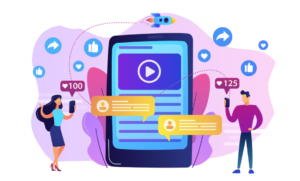Image SEO: Optimize Visual Content for Search
When we think of SEO (Search Engine Optimization), our minds often go straight to keywords, backlinks, and technical tweaks. But there’s one often-overlooked hero quietly shaping the way people experience your website: images. Yes, those visual snippets of beauty do more than just make your website look good Image SEO ensures they play a vital role in how your site performs in search engine results.
Welcome to the world of Image SEO, where art meets algorithm.
Whether you’re a blogger, eCommerce business owner, or digital marketer, optimizing your visual content can lead to faster load times, better accessibility, improved rankings, and ultimately, more traffic. In this blog, we’ll explore the why, what and how of image optimization so you can ensure every picture is truly worth a thousand (searchable) words.

Why Image SEO Matters More Than Ever
Before we get technical, let’s understand the importance of optimizing images from a human perspective:
-
People are visual learners: Our brains process visuals 60,000 times faster than text. A well-placed image can clarify concepts, evoke emotions, and drive engagement.
-
Images boost user experience: Clean, fast-loading, high-quality images create a seamless browsing experience and happy users are more likely to stay, explore, and convert.
-
Google cares about visuals too: Google Images accounts for more than 20% of all web searches. An optimized image can lead to significant organic traffic.
-
Accessibility and inclusivity: Optimizing images with alt text makes your website accessible to visually impaired users using screen readers, aligning with both ethics and regulations.
In short, ignoring image SEO is like publishing a book with no cover people might still find it, but it’s not going to stand out.

The Essentials of Image SEO: A Step-by-Step Guide
1. Choose the Right Image Format
Different file types serve different purposes. Picking the right one can reduce load time without compromising on quality.
-
JPEG: Best for photographs and images with gradients.
-
PNG: Ideal for images requiring transparency or sharp details (like logos).
-
WebP: Modern and efficient; balances quality and size beautifully (supported by most modern browsers).
-
SVG: Great for icons, logos, and illustrations that need to scale without losing clarity.
Pro tip: For most websites, WebP is the best balance between quality and speed. Consider using tools like Squoosh to convert images.
2. Resize and Compress Images
Uploading full resolution images straight from your DSLR or phone is a common mistake. Large images slow down your site, frustrate users, and hurt rankings.
-
Resize images to fit the container they will display in (no need for 4000px wide images on a 1200px container).
-
Use compression tools like TinyPNG, ImageOptim, or ShortPixel to reduce file size without noticeable quality loss.
Remember: Google loves fast-loading pages and so do your visitors.
3. Use Descriptive, Keyword-Rich File Names
Instead of uploading IMG_3748.jpg, use something meaningful like handmade-ceramic-coffee-mug.jpg. This not only tells Google what the image is about but also helps it appear in relevant image search results.
Don’t keyword stuff keep it natural, just like you would describe the image to a friend.
4. Add Alt Text with Purpose
Alt text (alternative text) serves multiple functions:
-
It describes the image to users who can’t see it.
-
It provides contextual relevance for search engines.
-
It boosts your chances of appearing in image based search results.
How to write great alt text:
-
Be clear and concise: “Golden retriever puppy playing in autumn leaves.”
-
Include relevant keywords naturally.
-
Don’t say “image of” or “picture of” screen readers already know it’s an image.
5. Optimize Image Titles and Captions
While not as critical as alt text, image titles and captions can add SEO value and improve user experience.
-
Titles show on hover and can provide additional context.
-
Captions are visible on the page and often read more than the body text, especially on blogs.
When used strategically, they can reinforce the message of the image and include additional keywords.
6. Create Image Sitemaps
If your site has a lot of visual content, adding an image sitemap helps search engines discover all your images even those loaded dynamically via JavaScript.
You can include image entries in your regular XML sitemap or create a separate image-specific sitemap. Many SEO plugins like Yoast and Rank Math do this automatically.
7. Lazy Loading for Faster Page Speed
Lazy loading delays the loading of images until they’re actually needed (i.e., when the user scrolls to them). This reduces initial page load time, improving both SEO and user experience.
Modern HTML supports lazy loading natively:
8. Use Structured Data (Schema Markup)
If your image is part of a product, recipe, or article, use structured data to help search engines understand its context.
For example:
-
Product schema for eCommerce images
-
Recipe schema for food blogs
-
Article schema for news sites
This can help your images appear as rich results in search, improving click-through rates.
- Define Your Goals: Whether it’s brand awareness, lead generation, or customer retention, set clear objectives.
- Know Your Audience: Understand their preferences, behavior, and the platforms they frequent.
- Create Engaging Content: Develop a content calendar with posts, videos, and campaigns tailored to your audience.
- Engage Consistently: Respond to comments, answer queries, and interact with your followers to build trust.
- Analyze and Adapt: Use analytics tools to track performance and refine your strategy.
Bonus: Make Your Visuals Work Beyond Google
Great image SEO is not just about search engines. It is about building brand visibility, creating shareable content, and engaging your audience. Here’s how:
-
Use consistent branding and style across images.
-
Include your logo or watermark (tastefully) where appropriate.
-
Make your visuals Pinterest– and Instagram-friendly with vertical orientation, compelling captions, and smart hashtags.
-
Add Open Graph and Twitter Card tags so your images display properly on social media.

In Summary: Image SEO Is Where Art Meets Algorithm
Optimizing your images is not just about shrinking file sizes or stuffing in keywords. It’s about creating a better experience for both your users and search engines. When done right, your visual content becomes discoverable, accessible, and impactful not just pretty decoration.
Take the time to treat your images with the same care you give your headlines and copy. Because in today’s content-driven world, visuals are not just support characters they’re co-stars.





